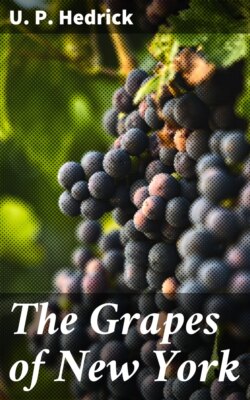Читать книгу The Grapes of New York - U. P. Hedrick - Страница 42
14. VITIS ARIZONICA Engelm.
Оглавление1. Engelmann, Am. Nat., 2:321. 1868. 2. Parry, U. S. D. A. Rpt., 1870:416. V. Arizonensis. 3. Engelmann, Mo. Ent. Rpt., 1872:62. 4. Ib., Bush. Cat., 1883:10, 12, 14, 16. Arizona grape. 5. Munson, Am. Hort. Soc. Rpt., 1885:132. Arizona grape. 6. Ib., Am. Pom. Soc. Rpt., 1885:97. Arizona grape. 7. Planchon, De Candolle’s Mon. Phan., 5:323, 342. 1887. V. Californica; V. Arizonensis; V. riparia. 8. Munson, Soc. Prom. Ag. Sci. Rpt., 1887:59. Arizona grape. 9. Ib., Gar. and For., 3:474. 1890. 10. Ib., U. S. D. A. Pom. Bul., 3:10. 1890. 11. Ib., Am. Gard., 12:660. 1891. Canyon grape. 12. Ib., Mich. Hort. Soc. Rpt., 1893:116. Gulch grape. 13. Munson, Bush. Cat., 1894:20. Canon grape. 14. Husmann, 1895:4, 189. 15. Bailey, Gray’s Syn. Fl., 1:425. 1897. Canon grape. 16. Beach, N. Y. Sta. An. Rpt., 17:536, 557. 1898. 17. Munson, Tex. Sta. Bul., 56:230, 239. 1900. Downy Canyon grape. 18. Viala and Ravaz, Am. Vines, 1903:102.
Vine weak in growth, shrubby or climbing moderately, numerous angular branchlets; diaphragms thick. Leaves mostly small, cordate, with rather open rounded petiolar sinus, entire or indistinctly three-lobed (sometimes distinctly lobed on young plants), coarsely and regularly toothed; thick, rigid, slightly rugose above, when young, white-woolly below, becoming nearly glabrous with age. Clusters small, compound; peduncle slender, of medium length. Berries black, small to medium in size; pleasant in taste. Seeds two to three of medium size; chalaza oval in shape, slightly distinct; raphe flat, usually inconspicuous, rarely prominent.
Arizonica was named and first described by Engelmann in 1868. It was later described by Parry, botanist of the Department of Agriculture, from specimens sent to him by Dr. Charles Smart, an army surgeon stationed in southern Arizona, in 1867. Parry says that Engelmann considered it a distinct species and had provisionally named it Vitis arizonensis. As to the name, this is evidently an error in quoting Engelmann.
Its habitat is “Western Texas, New Mexico, Arizona, Chihuahua (Mexico), and South Utah.”
This grape is adapted only to the arid districts of the West. When raised in humid climates it is subject to the attacks of mildew and black-rot. As might be expected from its habitat, it endures intense drouths. It grows well on limestone, pebbly, or alluvial soils. It has a considerable degree of resistance to phylloxera, grows readily from cuttings, and according to Munson, can withstand zero temperature without injury. As the European grapes can be raised in its native country, it is not there regarded as valuable, although the fruit is said to be rich in sugar and to be of pure flavor. It has been used in California as a stock, but is not regarded in any section very favorably and its use has never become extensive probably owing to its lack of vigor. It suckers less than Rupestris. Arizonica blossoms about the time of Labrusca. It is of no value to the grape-growers of the East and probably of none to those of the West.
